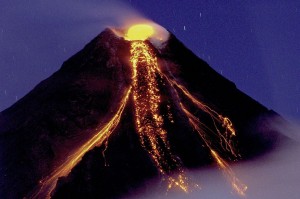
LEGAZPI CITY — The violent eruption of Mayon Volcano on Feb. 1, 1814, which left behind the iconic Cagsawa church ruins — the much photographed place in Albay province, has to be remembered to remind people on the extent of destruction the volcano can do and for the local government units (LGU) to complement preparedness in the face of strong eruptions, one of the country’s top scientist said.
“If we compare the 1814 eruption to the recent eruptions of Mayon Volcano starting in the 1960s, the 1814 eruption was far bigger than most recent eruptions. What is important is we look back at the big eruption of Mayon Volcano and then compare it with the preparation of the provincial government of Albay and the municipal governments,” Renato Solidum, director of the Philippine Institute of Volcanology and Seismology (Phivolcs), said during the 200th year commemoration of the 1814 eruption held here on Friday.
Solidum said what needs to be done “is to see if we are really prepared for those strong events because preparing for strong events would mean that we are prepared for smaller events.”
He said that since it had happened, there is no reason why it may not occur again.
Citing a study of volcanic debris of 1814 eruption uncovered by super typhoon “Reming” that unleashed deadly lahar in 2006, Solidum described the eruption in the early 19th century as far-reaching in terms of destruction.
“The first wave of destruction came fast within the six-kilometer danger zone with the pyroclastic surge of heated gases mixed with some volcanic debris travelling at least 100 km per hour,” the Phivolcs chief narrated.
Solidum said pyroclastic surge sucked the oxygen in the atmosphere and searing heat overwhelmed those places it overran which could instantly kill animals and humans due to asphyxiation or burning.
He said that immediately the pyroclastic flow, which carried more volcanic debris, rocks and sands, followed at slower speed and delivered the coup de grace on whatever surviving living things on its path.
“If we will look at the pyroclastic surge that time, it reached the Budiao Church which is within the extended eight-kilometer danger zone in few minutes. According to accounts, the pyroclastic surge even possibly reached Cagsawa, which is 12 km away from the crater.
Because the pyroclastic surge was much thinner and lighter than the pyroclastic flow, it was fast to cause the first wave of deaths along the path of destruction.
Solidum said the Cagsawa church was destroyed by the lahar flow, one meter to two meters in height, that deposited big rocks, sands, ashes, and pumice in its vicinity several days after eruption.
But, he said, the 1814 eruption of Mayon Volcano was small compared to the Mt. Pinatubo eruption in 1991 which was considered the biggest one that happened in the 20th century, lowering the temperature around the globe for several years.
According to Bicol historian Prof. Danilo Gerona, the 1814 eruption happened on a Tuesday, the first day of February, on the vesper of the Feast of Candelaria.
He said several accounts by Spanish friars in Albay and neighboring places had been recorded to describe the spectacular 1814 eruption, whose ashes reached a day later as far as Manila, 180 miles from Mayon Volcano.
Gerona said one Fray Tubino, based in Guinobatan, Albay, estimated a 12-km column of dark cloud blasted early in the morning from the crater and scattered tremendous amount of ash and gases on a wide scale.
Another observer of the 1814 eruption testified that ash fall also reached Bulacan, Pampanga and Pangasinan and based on the research of Fray Tubino, two years after the eruption, the ashes reached as far as China, the Bicol historian added.
Solidum said the major hazards of Mayon Volcano eruption are pyroclastic surge and pyroclastic flow, ejected rocks, molten lava and lahar.
He said 77 persons died in February 1993 and five mountain climbers were killed in May 2013 because there was no precursor to the steam eruption that surprised even the Phivolcs and residents near the slopes.
Solidum said the February 1993 eruption killed dozens because the tip of the crater of Mayon Volcano at the southern side was ripped off and the steam blast reached the six-kilometer permanent danger zone.
Daniel Nuñez, 53, resident of Barangay Mabinit where molten lava flowed and deposited by the recent eruptions, also said there was no sign Mayon Volcano was acting up.
Nuñez noted that usually wells dry up even if there is no drought, wild animals like wild fowls and pigs and civet go down to the populated area, or rumbling sounds could be heard before the occurrence of eruption.
But, he said, Mayon Volcano does not always give signs before acting up like the 1993 and May 2013 steam eruption that killed several people who were caught unaware.
Nuñez claimed that he believed there were more than a hundred people killed in 1993 steam eruption that happened at noon time on Feb. 2 but only more than 70 were recovered because there were farming families then still living within the permanent danger zone.
Mayon Volcano’s destructive power has been recorded in the sediments of areas near the volcano for thousands of years, according to Dr. Tetsou Kobayashi, professor in the University of Japan who conducted a study.
Kobayashi collected specimens of volcanic debris and ashes deposited in a quarry site in Nasisi, Guinobatan, Albay, which were carbon dated.